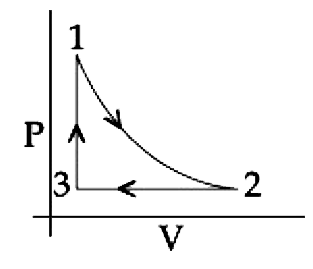Which of the following is true for an adiabatic process:
ΔH=0
ΔW=0
dq=0
ΔV=0
The correct Answer is:C
To solve the question regarding the characteristics of an adiabatic process, we will analyze the options provided and apply the principles of thermodynamics.
1. Understanding Adiabatic Process:
- An adiabatic process is defined as one in which no heat is exchanged with the surroundings. This means that the system is thermally insulated from its environment.
2. Analyzing the Options:
- Option A: Change in enthalpy is equal to 0.
- This is incorrect. In an adiabatic process, the enthalpy can change depending on the work done on or by the system.
- Option B: Change in work done is equal to 0.
- This is also incorrect. Work can be done on or by the system during an adiabatic process, so the change in work done is not necessarily zero.
- Option C: Change in heat is equal to 0.
- This is correct. Since an adiabatic process is defined by the absence of heat transfer, the change in heat (Q) is indeed zero (ΔQ = 0).
- Option D: Change in volume is equal to 0.
- This is incorrect. The volume of the system can change during an adiabatic process, especially in cases of gas expansion or compression.
3. Conclusion:
- The only true statement regarding an adiabatic process from the options provided is Option C: Change in heat is equal to 0.
Final Answer:
Option C: Change in heat is equal to 0.
- An adiabatic process is defined as one in which no heat is exchanged with the surroundings. This means that the system is thermally insulated from its environment.
- Option A: Change in enthalpy is equal to 0.
- This is incorrect. In an adiabatic process, the enthalpy can change depending on the work done on or by the system.
- Option B: Change in work done is equal to 0.
- This is also incorrect. Work can be done on or by the system during an adiabatic process, so the change in work done is not necessarily zero.
- Option C: Change in heat is equal to 0.
- This is correct. Since an adiabatic process is defined by the absence of heat transfer, the change in heat (Q) is indeed zero (ΔQ = 0).
- Option D: Change in volume is equal to 0.
- This is incorrect. The volume of the system can change during an adiabatic process, especially in cases of gas expansion or compression.
- The only true statement regarding an adiabatic process from the options provided is Option C: Change in heat is equal to 0.
Option C: Change in heat is equal to 0.
Topper's Solved these Questions
- BOOK - VMC MODULES ENGLISHCHAPTER - THERMODYNAMICSEXERCISE - LEVEL-250videos
THERMODYNAMICS
- BOOK - VMC MODULES ENGLISHCHAPTER - THERMODYNAMICSEXERCISE - LEVEL-2 (NUMERICAL VALUE TYPE)15videos
THERMODYNAMICS
- BOOK - VMC MODULES ENGLISHCHAPTER - THERMODYNAMICSEXERCISE - LEVEL-0 (LONG ANSWER TYPE (5 MARKS))6videos
THERMODYNAMICS
- BOOK - VMC MODULES ENGLISHCHAPTER - THERMOCHEMISTRYEXERCISE - JEE ADVANCED (ARCHIVE)31videos
THERMOCHEMISTRY
- BOOK - VMC MODULES ENGLISHCHAPTER - THERMODYNAMICS & THERMOCHEMISTRYEXERCISE - Impeccable48videos
THERMODYNAMICS & THERMOCHEMISTRY
Similar Questions
In adiabatic process
View SolutionIn an adiabatic process
View SolutionIn an adiabatic process-
View SolutionIn a adiabatic process.
View SolutionWhich of the following is true for spontaeous process :-
View SolutionWhich of the following is a feature of adiabatic expansion?
View SolutionWhich of the following is true for RNA processing ?
View SolutionWhich of the following is true about RNAi process ?
View SolutionAn adiabatic process occurs in
View SolutionWhich of the following is an equivalent cyclic process corresponding to the thermodynamic cycle given in the figure? Where, 1→2 is adiabatic. (Graphs are schematic and are not to scale)
 View Solution
View Solution

